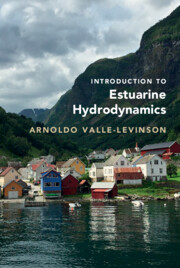Book contents
- Introduction to Estuarine Hydrodynamics
- Introduction to Estuarine Hydrodynamics
- Copyright page
- Contents
- Preface
- 1 Introduction and Classification
- 2 Conservation Equations
- 3 Tides in Semienclosed Basins
- 4 Shallow-Water Tides
- 5 Tidal Residual Flows in Homogeneous, Semienclosed Basins
- 6 Wind-Driven Flows in Homogeneous, Semienclosed Basins
- 7 Flows Driven by Density Gradients
- 8 Interactions among Tides, Density Gradients, and Wind
- 9 Fronts
- 10 Time Scales in Semienclosed Basins
- 11 Semienclosed Basins with Low or No Discharge
- 12 Classification of Semienclosed Basins, Based on Dynamics
- Index
- References
8 - Interactions among Tides, Density Gradients, and Wind
Published online by Cambridge University Press: 24 February 2022
- Introduction to Estuarine Hydrodynamics
- Introduction to Estuarine Hydrodynamics
- Copyright page
- Contents
- Preface
- 1 Introduction and Classification
- 2 Conservation Equations
- 3 Tides in Semienclosed Basins
- 4 Shallow-Water Tides
- 5 Tidal Residual Flows in Homogeneous, Semienclosed Basins
- 6 Wind-Driven Flows in Homogeneous, Semienclosed Basins
- 7 Flows Driven by Density Gradients
- 8 Interactions among Tides, Density Gradients, and Wind
- 9 Fronts
- 10 Time Scales in Semienclosed Basins
- 11 Semienclosed Basins with Low or No Discharge
- 12 Classification of Semienclosed Basins, Based on Dynamics
- Index
- References
Summary
This chapter considers interactions between different forcings. It first describes the interaction between tidal currents and density gradients at intratidal (within one tidal cycle) time scales. One outcome of this interaction is the phenomenon known as tidal straining. The chapter continues with the treatment of intratidal variations of density that can also result from the interaction of density fields with tides and bathymetry. Subsequently, the chapter presents a description of the interaction between tides and density gradients at subtidal time scales, that is, at periods greater than one tidal cycle. The chapter then describes how advective accelerations from tidal currents can interact with density gradients to modify residual flows. It follows with a description of the competition between tidal stresses and density gradients in driving residual flows. It then deals with the competition between density gradients and wind stresses, to later add tidal forcing. The chapter then includes the influence of river discharge on estuarine circulation. The last two subsections present salt (or solute) budgets and their linkage to hydrodynamics and approaches to study saltwater intrusion
Keywords
- Type
- Chapter
- Information
- Introduction to Estuarine Hydrodynamics , pp. 124 - 154Publisher: Cambridge University PressPrint publication year: 2022



